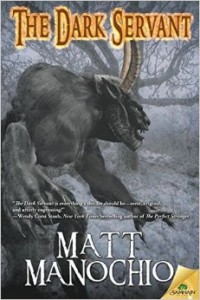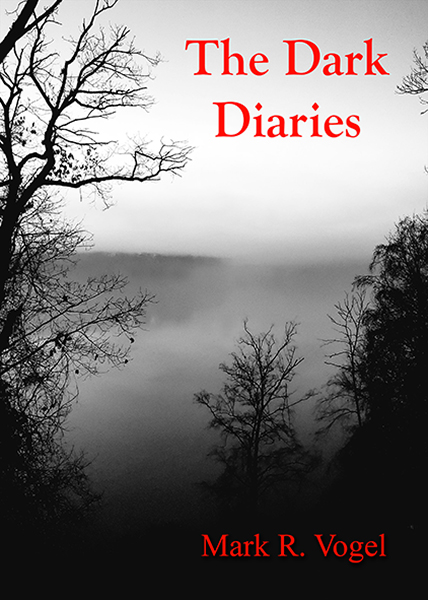
Matt Manochio
Samhain Publications
2014
Reviewed by Michael R. Collings
Matt Manochio’s The Dark Servant surprised me.
To be sure, it looked intriguing from the onset, with a nicely evocative cover by Scott Carpenter and an challenging title—there would be a formidable creature involved, that was certain, and it would be subordinate, presumably, to something even more terrifying.
The opening scene is nicely set: a high-school senior on his way to school, having an innuendo-laced cell-phone conversation with his girlfriend, only vaguely aware of a bad smell in the rural New Jersey air. Then, out of nowhere, hideous shrieks and an unsettling growl. And then….
A dangling modifier.
I couldn’t help it. Even after nearly a decade of retirement, the English professor in me couldn’t help but be jarred out of a narrative by an awkwardly constructed sentence. The boy, Travis Reardon, grabs an emergency flashlight from the glove box and shines it into the surrounding forest: “Eyes darting back and forth, the beam danced from here to there…”—and suddenly the flashlight beam has eyes. From that point, the book would have to prove itself for me.
Unfortunately, the next few pages contained additional wobbles, including awkward word choice (an “indecipherable” sun), repetitiousness, and the following, describing the police chief’s discovery of anomalous hoof prints near the scene of a crime: “He let the hoof impressions ruminate before responding.” My first response was something along the lines of “I didn’t know hoof prints could ponder, let alone chew their cud.”
Mostly because I don’t like giving up on any book, however, I decided to continue.
Fortunately.
Imagine, if you will, one of the most fearsome creatures from European mythology, “older,” as one character puts it, “than Christ.” Imagine that it has come to a small New Jersey town and begun kidnapping, not children but high-school students on the cusp of adulthood, leaving no traces of its presence other than wrecked cars and damaged property. Imagine that it is eight feet tall, furred, horned, with terrifying claws, bearing a wooden crate on its back, into which it stuffs its victims. Imagine that its actions seem at best either sociopathic or psychotic—or perhaps both, since it cares nothing for human values and rules and revels in inflicting pain.
Oh, and that it speaks English fluently, although with a slight but detectable German accent (which is deftly handled throughout).
And that it begins its depredations on December 5th.
And that it is kidnapping its victims on the orders of its Master…who, we discover, is none other than “…Nicholas of Myra! Saint Nicholas! Santa Claus!”
To reveal that connection is not a spoiler, because in important ways—and most surprisingly effective ways—the novel is not about the monster, the Krampus, that serves as Saint Nicholas’s “dark servant” in punishing evil and wicked children, although that seems, on the surface at least, the driving point of the narrative. No, what The Dark Servant concentrates on is the children themselves, adolescents at turning points in their young lives, making false choices and inadvertently setting themselves onto destructive paths. Sometimes the false choices are direct—physically bullying smaller, helpless children. Other times they are more damaging and potentially more lasting—for example, incessant cyber-bullying that can drive the victims to take appalling actions. And sometimes…but, no, that would be providing a spoiler.
Manochio tackles his tale with energy and verve (perhaps accounting for the occasional over-writing), blending brutal horror with moments of appropriate comedy, as when the rather myopic Krampus discovers that it has seriously misread the “Naughty List.” Manochio takes what might in other hands have been a silly novel—really, Santa Claus!—and transforms it into a credible, highly modernized morality tale of guilt and punishment, of justice and retribution, of intent and responsibility. He seeds the narrative with carefully paced bits of information that make the revelation of the creature’s identity inevitable but not intrusive, keying crucial bits of the story-telling to, of all things, school assignments, and by doing so making fantastic elements The Dark Servant more plausible. He incorporates recent technology into a mythic story in such a way as to make the conclusion satisfying. And he does so while maintaining interest in and focus on a handful of young people who are simultaneously unique and universal. By the end, the infelicities of writing are largely forgotten (except, obviously, by obsessive-compulsive English teachers, retired or not) and what remains is the resonant, final thematic statement: “You cannot kill evil—only its host.”
I’m glad that The Dark Servant surprised me. I’m glad that I continued reading. It was well worth it.
- Killing Time – Book Review - February 6, 2018
- The Cthulhu Casebooks: Sherlock Holmes and the Miskatonic Monstrosities – Book Review - January 19, 2018
- The Best Horror of the Year, Volume Nine – Book Review - December 19, 2017
- Widow’s Point – Book Review - December 14, 2017
- Sharkantula – Book Review - November 8, 2017
- Cthulhu Deep Down Under – Book Review - October 31, 2017
- When the Night Owl Screams – Book Review - October 30, 2017
- Leviathan: Ghost Rig – Book Review - September 29, 2017
- Cthulhu Blues – Book Review - September 20, 2017
- Snaked: Deep Sea Rising – Book Review - September 4, 2017


